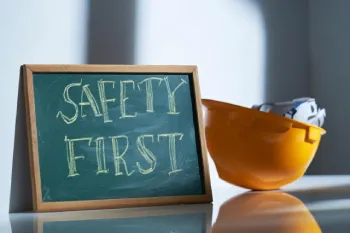Workplace (Health, Safety and Welfare) Regulations 1992
As a frontline security officer, your role often places you in diverse environments—shopping centres, office blocks, industrial estates, or outdoor sites. Each environment carries risks, especially when it comes to slips, trips, and falls. The Workplace (Health, Safety and Welfare) Regulations 1992 were introduced to make sure that all workplaces are safe and suitable for the people who work in them. For you, this means your employer must provide a safe working environment, and you also have a duty to follow safe practices.

Understanding these regulations isn’t just about compliance; it’s about keeping yourself and others safe, reducing accidents, and maintaining professionalism on duty.
What the Regulations Cover
The Workplace (Health, Safety and Welfare) Regulations 1992 set minimum requirements for health, safety, and welfare in most workplaces. Key areas relevant to you as a security officer include:
Safe access and egress: Entrances, exits, corridors, and staircases must be kept clear and safe.
Good housekeeping: Floors should be free from hazards such as trailing cables, wet patches, or litter.
Floor conditions: Surfaces must be suitable, in good repair, and not slippery.
Lighting: Adequate lighting is required to identify hazards, especially important for night security patrols.
Sanitary and welfare provisions: Facilities for rest, toilets, and drinking water must be provided.
Did You Know?
HSE reports show that slips, trips, and falls account for over one-third of major injuries in UK workplaces every year.
Poor maintenance and lighting are among the top breaches of these regulations.
The economic cost to employers exceeds £500 million annually.
Real-World Example
Imagine you’re patrolling an office building on a rainy evening. Visitors track water into the lobby, leaving the tiled floor slippery. Under the regulations, the building management (your employer or client) should ensure mats are placed near entrances and warning signs are displayed.
However, as the security officer, you also play a key role—spotting the risk, reporting it immediately, and, if safe to do so, putting out a “wet floor” sign until the cleaning staff attend.
Why It Matters: Consequences of Non-Compliance
For You: A slip, trip, or fall could mean days or weeks off work, loss of earnings, and even long-term injury.
For Employers: Fines, compensation claims, and loss of reputation. The HSE has prosecuted organisations for failing to comply with workplace safety laws.
For the Public: Visitors and contractors may also be at risk, leading to serious injury and liability for your employer or client.
Did you know? According to the HSE, slips, trips, and falls are the most common workplace accident in the UK, accounting for around 30% of all reported injuries.
Tips for Security Officers – Staying One Step Ahead
Keep your eyes open
Think of yourself as the “hazard radar” on site. Whether it’s a wet floor by the entrance, a frayed carpet in reception, or a fire exit blocked by deliveries, your sharp eyes can spot the danger before it causes harm.
Report it—don’t ignore it
If you see it, say it! Use the reporting system straight away and log the details. Remember, assuming “someone else will deal with it” is how accidents happen.
Take action where you can
Can you place a wet floor cone? Reroute people away from the danger? Alert cleaning staff? Small, safe actions make a big difference until the issue is fixed.
Dress for safety, not just for show
Your footwear is part of your kit. Non-slip, sturdy shoes aren’t just comfortable for long shifts—they’re your first line of defence against slips and trips.
Speak up and be clear
If you spot a hazard, don’t keep it to yourself. Politely warn staff, contractors, or visitors nearby. A simple “Careful, the floor’s wet here” could stop someone from ending up in A&E.
Scenario for Reflection
You’re on duty at a busy shopping centre. A child drops a fizzy drink on the escalator entrance, leaving it sticky and slippery. What should you do?
A. Walk past—it’s not your job.
B. Stop people using the area, report it, and request cleaning staff, placing signage if available.
C. Attempt to clean it yourself without equipment.
Correct response: B – You are not the cleaner, but as the security officer you are responsible for identifying, reporting, and preventing harm until the issue is resolved.
Key Considerations for Security Officers
These regulations are part of UK law and are reinforced by SIA licence-linked training, HSE guidance, and BSI standards for safe workplace design.
Your role is not just about guarding people and property—it’s also about ensuring the workplace meets these safety standards.
The NSI (National Security Inspectorate) also assesses organisations on health and safety as part of accreditation, so your actions contribute directly to compliance.
Safety is Part of Your Professionalism
The Workplace (Health, Safety and Welfare) Regulations 1992 are not just legal requirements—they are practical tools to help you, as a security officer, keep your workplace safe. By being alert, proactive, and compliant, you not only protect yourself but also demonstrate professionalism and commitment to safety in every shift you work.

